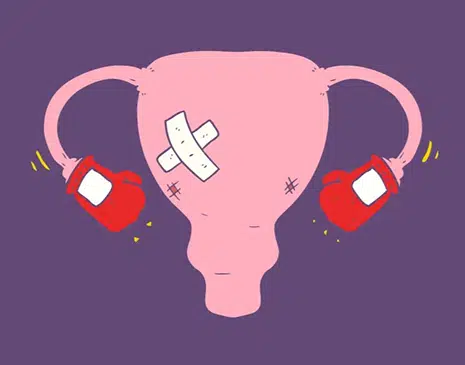As women, we’ve grown accustomed to the fact that we may have to deal with a little discomfort when our monthly flow arrives. With the number of hormonal fluctuations occurring in our bodies at that time, a little pain is considered somewhat normal. What isn’t normal is when a little period pain evolves into a lot of period pain.
You know what we mean. The kind of crippling pain that has you curled up in a ball, suffering through sharp stomach cramps, on the verge of vomiting, just wishing your day away. This type of pain is anything but normal and it may be a sign that you are 1 of 700,000 women living with endometriosis in Australia.
As usual, girls, we’ve got your backs (and your lady parts, too), so we’re sharing the causes, symptoms and treatment options for endometriosis. This info may be the missing piece in your puzzle to living a pain-free life, and you are so welcome.
What is endometriosis?
Endometriosis is a chronic condition where cells similar to the uterine lining grow in places outside the uterus. These cells can grow on the ovaries, pelvis, bladder, bowel, and fallopian tubes. To understand why this isn’t normal bodily behaviour, we need to chat about menstruation. Just before a period hits, estrogen and progesterone stimulate the growth of the lining of the uterus. This lining is called endometrium, and if all goes according to plan this is what sheds from the body each month through the cervix and vaginal canal.
For someone with endo, cells growing outside the uterus try to imitate the endometrium (aka period blood). These cells react to the same hormonal fluctuations of the menstrual cycle. They build up and then they try to shed like a normal period. However, unlike a normal period, the abnormal cells have no outlet to flee the body. They become trapped inside the body and this causes inflammation, pain, and potential growth of scar tissue on organs.
What causes endometriosis?
Scientists still haven’t tapped into the exact cause of endo. Since the condition runs in families, genetics could be to blame. However, symptoms vary from person to person and there is no substantial proof that endo is hereditary.
Another theory is retrograde menstruation. This is where menstrual blood flows backwards from the uterus into the fallopian tubes before attaching itself to other organs rather than taking the designated exit through the cervix and vaginal canal. And, you thought Mercury in retrograde was bad!
What are the symptoms of endometriosis?
The symptoms of endometriosis can range from non-existent to severe and they vary from person to person, which only adds to the mystery of this debilitating condition. Typical symptoms can include:
- Abnormally heavy or painful periods that often cause a missed day of school or work
- Chronic fatigue
- Intense period cramps (think; stabbing pains in the abdominal region)
- Pain during sex
- Painful bowel movements and urination
- Blood in pee and/or poo
- Pelvic and lower back pain that worsens at the time of your period
- Infertility
Endometriosis symptoms are progressive – they start as minor pain and worsen over time.
How is endometriosis diagnosed?
On average, it takes 6-and-a-half years for those living with endometriosis to be diagnosed in Australia. This is due to symptoms of endo being misdiagnosed as IBS, PMS, PCOS, or an STI. Since endometriosis doesn’t show up on scans or blood tests, the only definitive method of diagnosis is via laparoscopy – a surgery that involves passing a thin tube through a small incision in the stomach to identify endometriosis tissue for further inspection.
What is the treatment for endometriosis?
There is no known cure for endometriosis. The first line of defence to relieve symptoms of endometriosis is over-the-counter and prescription painkillers. If they’re not enough, hormone treatments like the oral contraceptive pill and IUD will help to stop the hormonal fluctuations that cause endometrium to build and shed every month.
Endometriosis is a difficult condition to live with. If you are suffering from intense pain and discomfort during your menstrual cycle and believe you may have endo, start by keeping a record of your symptoms so they’re available to show your doctor if the time arrives. Ain’t nobody got time for a 6-and-a-half-year diagnosis timeline. Let’s #smashthetaboo and bring the conversation of endo to light.
This blog is designed to be informative and educational. It is not intended to provide specific medical advice or replace advice from your medical practitioner.













